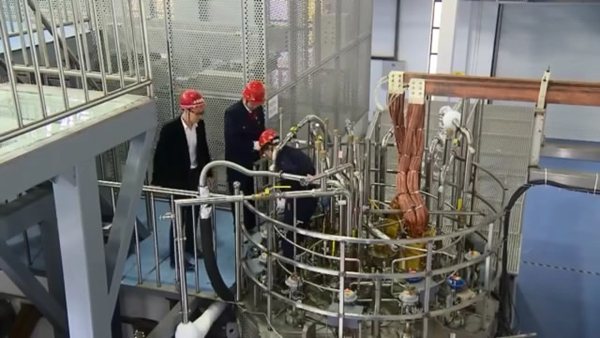


China's Steady High Magnetic Field Facility (SHMFF) on Wednesday passed testing by an expert panel organized by the National Development Reform Commission, according to local media.
The SHMFF, located in eastern China's Anhui Province, is a hybrid magnet group that can generate a magnetic field as high as 40 Tesla, one of only two groups in the world with such a capability.
So basically, it's a group of super-powerful electric magnets, and the related research facilities around it.
Why does it matter?
The machine is jointly built by Hefei Institute of Physical Sciences of the Chinese Academy of Sciences (CASHIPS) and the University of Science and Technology of China.
It took them nine years to build the machine, aiming at providing an experimental environment for fields such as high-temperature superconductivity, quantum materials and life science.

The logo printed on the SHMFF /CCTV Photo
The SHMFF can help scientists examine physical phenomena that are otherwise unavailable.
"It's already been used in more than 100 researches before the panel test," said Wang Yingjian, Party chief of CASHIPS. "The trial operation began in 2010."
A total of 19 accomplishments closely linked to high magnetic fields have won Nobel Prizes since 1913.
The technology is also applied to medical uses like magnetic resonance imaging (MRI), where a stronger field can help generate clearer images.
"It's not about the revenue it can generate. It's about the science explorations in our future," Li Yadong, professor at Tsinghua University and CAS member, told Anhui TV.
Scientific ambition
China has been trying to create a world-class research environment with the aim of attracting more top scientists to work in the country.
The "Science Island" in Hefei has already drawn many overseas Chinese back to their homeland.

Engineers calibrate the SHMFF. /CCTV Photo
Click here to find out how seven Harvard researchers feel after spending eight years working on the Science Island.
In addition to the SHMFF, China has also built FAST, the world's largest radio telescope, to peer through space like humans have never done.
The Chinese government created a long-term plan for building facilities on basic science research in 2013, in which it promised more equipment.
Stay tuned to CGTN to find out more scientific developments in China.
 Fire brigade in Shanghai holds group wedding
Fire brigade in Shanghai holds group wedding Tourists enjoy ice sculptures in Datan Town, north China
Tourists enjoy ice sculptures in Datan Town, north China Sunset scenery of Dayan Pagoda in Xi'an
Sunset scenery of Dayan Pagoda in Xi'an Tourists have fun at scenic spot in Nanlong Town, NW China
Tourists have fun at scenic spot in Nanlong Town, NW China Harbin attracts tourists by making best use of ice in winter
Harbin attracts tourists by making best use of ice in winter In pics: FIS Alpine Ski Women's World Cup Slalom
In pics: FIS Alpine Ski Women's World Cup Slalom Black-necked cranes rest at reservoir in Lhunzhub County, Lhasa
Black-necked cranes rest at reservoir in Lhunzhub County, Lhasa China's FAST telescope will be available to foreign scientists in April
China's FAST telescope will be available to foreign scientists in April "She power" plays indispensable role in poverty alleviation
"She power" plays indispensable role in poverty alleviation Top 10 world news events of People's Daily in 2020
Top 10 world news events of People's Daily in 2020 Top 10 China news events of People's Daily in 2020
Top 10 China news events of People's Daily in 2020 Top 10 media buzzwords of 2020
Top 10 media buzzwords of 2020 Year-ender:10 major tourism stories of 2020
Year-ender:10 major tourism stories of 2020 No interference in Venezuelan issues
No interference in Venezuelan issues
 Biz prepares for trade spat
Biz prepares for trade spat
 Broadcasting Continent
Broadcasting Continent Australia wins Chinese CEOs as US loses
Australia wins Chinese CEOs as US loses